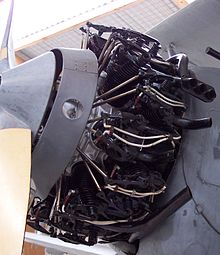Armstrong Siddeley Jaguar
The Armstrong Siddeley Jaguar is an aircraft engine that the British manufacturer Armstrong Siddeley built from 1922. The air-cooled two-row 14-cylinder radial engine has displacements from 22,532 to 24,785 cm³. The Jaguar III came in 1923, the Jaguar IV in 1925 and the Jaguar VI in 1927.
construction and development
The Jaguar was developed from a design proposal from the Royal Aircraft Factory (RAF.8) and was designed for the use of a compressor with a reduction gear. In the test run on June 21, 1922, the power output was worse than expected, so the cylinder bore was enlarged to 139.7 mm. All variants made after the Jaguar I have this enlarged cylinder bore. Due to the lack of a central crankshaft bearing, the Jaguar suffered from vibrations throughout its construction period.
The most powerful variant Jaguar VIC developed a take-off power of 490 bhp (365 kW) at 1950 rpm and weighed 413 kg. The later built Lynx had only one star with Jaguar cylinders.
variants
- Jaguar I
- 1922, 300 bhp (223 kW)
- Jaguar II
- 1923, 385 bhp (287 kW), larger cylinder bore, displacement 24,785 cm³.
- Jaguar III
- 1923, 385 bhp (287 kW).
- Jaguar IIIA
- 1923, 380 bhp (283 kW).
- Jaguar IV
- 1925, 385 bhp (287 kW), double carburetor.
- Jaguar IVA
- 420 bhp (313 kW), reduction gear for the propeller.
- Jaguar IVC
- 1928, 400 bhp (298 kW), redesigned connecting rods , encapsulated valve train.
- Jaguar IV (S)
- 1925, 365 bhp (272 kW), with compressor.
- Jaguar V
- 1928.
- Jaguar VI
- 1927.
- Jaguar VI (S)
- 1928, supercharged version of the Jaguar VI.
- Jaguar VIC
- 1927, 470 bhp (350 kW), Jaguar VI with reduction gear for the propeller.
- Jaguar VID
- 1928.
- Jaguar VIIA
- 1929, 400 bhp (298 kW), with compressor.
- Jaguar VIII
- 1928, 405 bhp (302 kW), with compressor and reduction gear for the propeller.
Aircraft with Armstrong Siddeley Jaguar
Motors on display
A surviving Armstrong Siddeley Jaguar can be seen in the Science Museum in London .
Data (Jaguar I)

General
- Two-row 14-cylinder radial engine, air-cooled, with compressor
- Bore: 127 mm
- Stroke: 127 mm
- Displacement: 22,532 cm³
- Length: 1041 mm
- Diameter: 1092 mm
- Weight: 322 kg
Components
- Compressor: with reduction gear
- Mixture preparation: carburettor
- Cooling: air
- Reduction gear: no
power
- Power: 680 bhp (507 kW)
- Output per liter: 22.50 kW / l
- Compression: 5: 1
- Petrol consumption: 71 l / h
- Power-to-weight ratio : 0.635 kg / kW
Individual evidence
- ^ A b Alec Lumsden: British Piston Engines and their Aircraft. Airlife Publishing, Marlborough, Wiltshire 2003, ISBN 1-85310-294-6 , pp. 63-66.
- ^ Alec Lumsden: British Piston Engines and their Aircraft. Airlife Publishing, Marlborough, Wiltshire 2003, ISBN 1-85310-294-6 , Appendix 4: Engine Performance Figures
- ^ Bill Gunston: World Encyclopedia of Aero Engines. Patrick Stephens, Cambridge 1989, ISBN 1-85260-163-9 , p. 18.
literature
- Alec Lumsden: British Piston Engines and their Aircraft. Airlife Publishing, Marlborough, Wiltshire 2003, ISBN 1-85310-294-6 .
